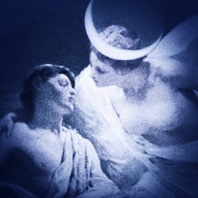Sir Charles Spencer Chaplin (1889–1977) is considered one of the first movie stars ever and made film history with his acting and his works. He is also one of the few artists who managed the transition from silent films to sound films.
Because of using archetypal imagery and symbols in his films, it is natural that the moon could also play a part somewhere. We found four references:
Read more
The word »mooncalf« is connected to a sad story, because in earlier centuries it was used for calves that were born malformed. It was assumed that the Moon was responsible for this, which was generally seen as a symbol of the feminine and dark side of life. Not exactly fair toward the Moon and unfortunately characteristic for the attitude wanting to assign the good to the masculine and the evil to the feminine.
Read more
Astrology, the teaching of the interpretation and meaning of star constellations for human life, shows once again the sun’s dominance in our society and the insignificant role the Moon plays. Everyone knows »his/her« sign of the zodiac, meaning the position of the Sun at the time of their birth. If you say, for example, »I am an Aquarius«, you refer to the fact that the Sun was positioned in the astrological sign Aquarius when you were born. Also, some people are still aware of the ascendant, being the sign, which was on the eastern horizon at the time of birth (lat. ascendere = to rise). But which sign the Moon is in their birth horoscope, only very few people know.
Read more
Selene is the Greek moon goddess, she is a daughter of Hyperion and Theia from the Titans, a race of deities. The two siblings of Selene are Eos (the goddess of dawn) and Helios (the god of the sun). These three, forge the bridge between day and night, the Sun and the Moon, masculine and feminine. Later, in Greek mythology, Selene has also been equated with Artemis, just like Apollo is linked with the sun god Helios.
Read more
The antlion is the larva of the myrmeleon, which belongs to the net-winged insects. This insect grows to be 0.6 inches and predominantly stands out because of its large jaw pincers, which let you anticipate its predatory disposition. The antlion is famous for its sophisticated method catching prey. It digs funnels in the sand that function like a trap for other insects (i.e., ants or spiders). When prey steps on the edge of the funnel, the antlion begins to throw sand on the animal from the bottom of the funnel. The thereby created movements, activate the slipping of the funnel walls and transport the prey directly into the fangs of the antlion, who then kills them with its poison.
Read more
It is well known that the tides are caused by the tidal forces that are formed through gravity between the Earth and the Moon (and also between the Earth and the Sun). To put it simply, you can say that the Moon moves masses of ocean waters. At the full moon and the new moon, the Sun, the Moon and the Earth are roughly in alignment, hence, the forces are greater and cause so-called spring tides, thus a slightly higher tide. Now, many people conclude that the Moon – and in particular the full moon – ought to move and influence us people accordingly, because our bodies consist mostly of water. This claim contains several errors in reasoning, which we would like to explain in the following.
Read more
Buzz Aldrin (* 1930) is an American astronaut and the man, who, as part of the Apollo 11 mission on 21st July 1969, stepped onto the Moon as the second person, just after Neil Armstrong. He stood in the shadow of his colleague and one could assume that he may have suffered under these circumstances. But this was not the case, he did not really want to be in the spotlight and was satisfied coming second. After he set his feet into the dust 20 minutes after Armstrong did, he said: »Beautiful, beautiful. Magnificent desolation.«
Read more
We are looking again at China, where next to the moon festival in autumn, an event is celebrated at the beginning of the year, which is also connected to the full moon: the Lantern Festival (»Yuanxiao«). This celebration is traditionally held on the 15th day of the first moon month of the old Chinese calendars and therefore coincides (more or less exactly) with the full moon. The Lantern Festival indicates the end of the Chinese New Year ceremonies.
Read more
This article is about the stop motion movie “Corpse Bride” (2005) by Tim Burton, the master of bizarre and subtle productions. The movie is based on a Russian legend “Corpse Bride” and captures the story of a wedding between two people of varying social backgrounds (Victor & Victoria) or rather differing worlds (Victor & Emily), with the resulting tension.
Read more
Ian Fleming’s fictitious secret agent 007, of the British Secret Service MI6, has been fighting the villains of this world on screen for over 50 years, accompanied by technical knick-knacks, all sorts of explosions and always beautiful women. There are many night scenes and one should assume that the Moon should be included quite frequently … far from it! We were only able to spot one Bond flic where the full moon can be seen: MOONRAKER from 1979 – and only at the beginning and the end of the movie.
Read more









